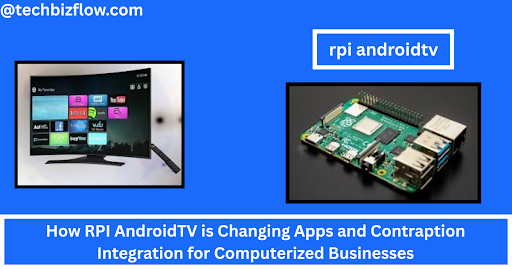Introduction: The Advanced Trade Scene Is Shifting
In today’s hyper-connected world, computerized businesses are under consistent pressure to improve. As shoppers become more tech-savvy, the instruments and platforms that companies utilize must advance quickly. One of the lesser-discussed yet game-changing improvements in this space is the rise of RPI Android TV. This crossbreed of the Raspberry Pi’s flexibility and AndroidTV’s interface is discreetly reshaping how businesses coordinate apps and keen contraptions into their operations, client encounters, and benefit offerings.
What is RPI AndroidTV?
Before plunging into its effect, let’s characterize the term. RPI AndroidTV is a setup where the AndroidTV working framework runs on a Raspberry Pi (RPI) board. Raspberry Pi, known for its Moo fetched and versatility, becomes a media powerhouse when matched with Android TV. This combination permits engineers and businesses to construct shrewd TV encounters, intelligent booths, and advanced signage frameworks at a fraction of conventional equipment costs.
Affordable Development for Little and Medium Undertakings (SMEs)
Not every company can bear a restrictive, sophisticated gadget biological system or high-end intelligent display units. Here, RPI AndroidTV sparkles. For under $100, businesses can model or indeed send completely working Android TV-based applications. This democratizes access to keen tech, permitting SMEs to:
- Deploy custom video spilling solutions
- Integrate voice-activated services
- Display real-time analytics dashboards
- Use an intuitive interface for client feedback
Example: A Nearby Exercise center utilizing RPI AndroidTV
A wellness center utilized RPI AndroidTV to construct a custom video stand. Individuals might observe workout recordings, track their progress through a companion app, and plan classes. The whole framework taken a toll less than two exercise center participations but made a more locked-in client experience.
App Environment Expansion
Running Android TV on Raspberry Pi opens up access to the Google Play Store (with a few workarounds) and APK sideloading. Businesses can use:
- Streaming apps (YouTube, Netflix)
- Health following dashboards
- POS systems
- Interactive menus for cafes or hotels
With negligible coding, they can indeed create custom apps optimized for Android TV, custom-fitted to their particular commerce needs.
Seamless Contraption Integration
Smart contraptions are all over, from voice collaborators to IoT temperature sensors. But joining these gadgets into a cohesive framework is a challenge. RPI AndroidTV streamlines this:
- It acts as a central hub.
- It interfaces effortlessly through Bluetooth, Wi-Fi, or GPIO.
- Supports integration with stages like Google Domestic and MQTT.
Smart Office Example
A co-working space utilized RPI AndroidTV to oversee its environment. It associated shrewd lights, room occupancy sensors, and a calendar planning computer program into one interface shown on a wall-mounted screen. Representatives seem to check room accessibility, control lighting, and see the day’s plan, all from one device.
Enhanced Client Experience
Modern customers anticipate interactivity and personalization. RPI AndroidTV conveys both. Its visual nature permits businesses to make locks in UI/UX interfaces that enhance:
- Product discovery
- Digital signage content
- Virtual concierge services
- Interactive entertainment
In Retail: Savvy Item Demos
Retailers are utilizing RPI AndroidTV-powered screens to showcase energetic item demos. Instead of inactive blurbs, clients see recordings, how-to guides, and indeed AR sneak peeks (utilizing companion apps). This leads to way better item understanding and higher deal conversions.
Scalable and Customizable
Perhaps the most compelling highlight is how versatile RPI Android TV frameworks are. Whether you’re running a single intelligent show or hundreds of screens over different areas, the setup can develop with you. Additionally, businesses can:
- Push upgrades remotely
- Monitor utilization stats
- Customize branding and interface
Multi-Location Rollout Case Study
A territorial eatery chain sent RPI AndroidTV for its computerized menu sheets. They seem to upgrade all areas at the same time with modern advancements or menu items. This cuts down printing costs and reaction times dramatically.
Developer-Friendly Environment
RPI AndroidTV bolsters a wide assortment of programming languages and frameworks:
- Java/Kotlin for Android apps
- Python for back-end logic
- Node.js for real-time communication
There’s a solid engineer community around both Raspberry Pi and Android TV, advertising direction, libraries, and plugins that speed up deployment.
Rapid Prototyping
Startups adore how quickly they can test thoughts. In a day, a fundamental MVP can be built utilizing RPI AndroidTV to exhibit a modern advanced item, app interface, or shrewd gadget control panel.
Energy Proficient and Compact
RPI AndroidTV arrangements are energy efficient. They have negligible control, can be powered by means of USB, and do not require cooling frameworks like conventional media PCs. Their little estimate permits simple mounting behind screens or interior booths, keeping setups clean and professional.
Hospitality Application
Hotels are inserting RPI AndroidTV gadgets behind TVs to give a branded welcome screen, city guides, and visitor benefit apps — all without bulky equipment or costly contracts.
Security and Protection Controls
Security is continuously a concern in advanced trade devices. With RPI AndroidTV, companies have full control over what runs, what interfaces, and who gets access to the system.
- Regular overhauls through open-source communities
- Firewall and VPN configurations
- App consent management
This makes it a solid alternative for businesses that deal with client information or are required to comply with regulations like GDPR.
Future Patterns: Where RPI AndroidTV Is Headed
The merging of low-cost computing and keen interfacing is a fair start. As the equipment advances (Raspberry Pi 5 and past), we can expect:
- Higher execution graphics
- Voice and motion control
- AI integration (e.g., facial recognition)
- Greater bolster for 4K and indeed 8K displays
This clears the way for cutting-edge retail encounters, more brilliant workplaces, and immersive excitement setups that were once reserved for huge tech corporations.
Practical Challenges to Consider
Of course, there are limitations:
- Not all AndroidTV highlights run flawlessly on Raspberry Pi.
- Some apps require workarounds to function.
- Hardware overheating can happen in seriously usage.
However, with appropriate arrangement (like utilizing heatsinks, optimized apps, and custom-made use-cases), these obstacles are manageable.
Conclusion: A Calm Transformation in Tech Integration
RPI AndroidTV might not snatch features like other showy advancements, but its real-world effect is verifiable. It’s enabling advanced businesses of all sizes to take control of their tech stack, upgrade client engagement, and send adaptable, savvy arrangements without breaking the bank.
Whether it’s a boutique inn advertising personalized advanced concierge services, a neighborhood shop showing energetic advertisements, or a startup making a savvy domestic demo unit, RPI AndroidTV is demonstrating to be an unforeseen saint in the advanced travel. And with the developing environment encompassing it, the conceivable outcomes are fair getting started.
FAQs
What is RPI AndroidTV?
RPI AndroidTV is a custom setup where AndroidTV runs on a Raspberry Pi, empowering reasonable, savvy show solutions.
Can businesses utilize RPI AndroidTV for commercial apps?
Yes, numerous businesses utilize it to run and create custom AndroidTV apps for signage, streaming, and intuitive interfaces.
Is RPI AndroidTV congruous with shrewd contraptions and IoT devices?
It underpins consistent integration with keen contraptions by means of Wi-Fi, Bluetooth, or GPIO.
Is RPI AndroidTV reasonable for large-scale deployments?
Yes, it’s adaptable and perfect for businesses requiring reasonable, customizable arrangements over different locations.


